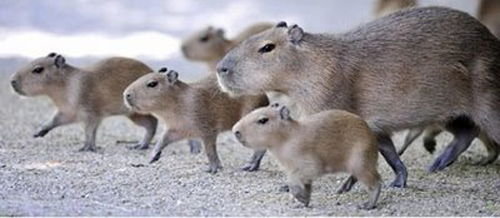

They have teeth at birth and the chewing is done to grind their teeth. Capybaras are semi aquatic animals and require water for daily. They bond with what there are raised with at the time.

They will stand up and beg for corn, follow you around the yard and my pet would love to get in your lap. Feeding time is a special time for then and for you. Outside they swim, run, eat and lounge in the sun during the day. They can be brought in if you want your rugs chewed, table legs gnawed, curtains pulled off the windows, and a possible mess in the floor. Many people want to bring them in the house and try to “potty “train them. In addition to grasses, the species also feeds on aquatic plants as well as grains, melons, and squashes.

A typical group is headed by a dominant male and possesses a hierarchy established and maintained by aggression and fighting. Species members are normally found in herds containing 20 individuals, although smaller groupings, comprising only family members, are also seen. They have jaguars, ocelots, snakes, alligators, and wild dogs as natural predators. The capybara can also swim totally submerged for long distances. The life expectancy of a capybara is fifteen years. hydrochaeris enters the water, where it may swim to safety, with only its nostrils, eyes, and ears exposed, or it may hide in floating vegetation, with only its nostrils exposed. In areas where it is frequently bothered by humans, however, the animal has become nocturnal. The capybara is active in the morning and evening, wallowing in mudholes and shallow water during the hottest part of the day. Yet they nearly always return to the same spot at night. Each day the capybara troops must travel long distances in search of food. Bachelor males often band together in separate groups. To help the numbers remain stable in the wild capybaras are being farmed for their meat as part of mammal management plan in Venezuela & Colombia.Ĭapybaras are the largest living rodent! Their head & body length is between 100–130 cm and they can weigh up to 61 kg.Typically, each family group includes one adult male and one or more females, with their young. Humans also pose a threat with illegal poaching, and t hey are at risk of habitat loss through deforestation & habitat destruction. They live in small family groups of about 10 – 20 individuals.Ĭapybaras face several predators like jaguars, anacondas, aimans, pumas, ocelots and harpy eagles so living by a constant source of water is important for them to be able to hide and retreat into murky waters escaping the predators. During mating the female has the advantage and mating choice, and if a female does not want to mate with a certain male, she will either submerge in the water (being able to hide under water for up to 5 minutes at a time) or just leave the water all together. They are herbivores feeding mainly on grasses, water plants, buds, soft tree bark, reeds & grains.Ĭapybaras are semi-aquatic, spending a lot of time in the water, in fact they only mate in water. We have two capybara brothers at the park! They are both big eaters but when they aren’t eating they love to go for a swim or relax & have a good nap!Ĭapybaras are found in savannas and rainforest, near ponds, rivers, or lakes across Central America & Northern South America.


 0 kommentar(er)
0 kommentar(er)
